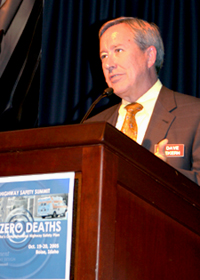
|
CONNECTIONS
|
IDAHO
ITD
HOME
IDAHO DMV
ITD NEWS
HIGHWAY
SAFETY
IDAHO STATE
POLICE
TRAVEL SERVICES
STATE OF IDAHO
NATIONAL
AASHTO
AAMVA
AAA of IDAHO
FEDERAL HIGHWAYS
FEDERAL AVIATION
IDAHO STATE POLICE
NHTSA
NTSB
TRB
U.S. DOT
Idaho
Transportation
Department
Public Affairs Office
P.O. Box 7129
Boise, ID 83707
208.334.8005
Fax: 208.334.8563
Email


–Setting
an agenda for life –
Leaders look for ways of moving toward zero fatalities
Leaders from throughout Idaho joined national experts this week at Boise State University to begin creating an agenda for life – a comprehensive statewide strategy for reducing the number of deaths on highways, roads and streets.
“Every day, in homes across Idaho, the families and friends of motor vehicle accident victims bear the anguish of needless injuries and loss of life,” Gov. Dirk Kempthorne said in videotaped opening remarks for the “Governor’s Highway Safety Summit: Toward Zero Deaths.” He was testifying before a House committee in Washington, D.C. on the role of the National Guard and was unable to speak at the safety summit.
“More than 200 Idahoans are likely to lose their lives on our highways this year. That is simply unacceptable,” the governor added.
Last year, 260 individuals lost their life in Idaho traffic crashes, a decline of more than 11 percent from the pervious year when crashes claimed 293.
“But we can do more. And, that is why I look forward to working with you to help achieve our goal of moving “toward zero deaths” on Idaho’s highways. It is time to act decisively. It is time that highway safety becomes more than just our highest priority – that it becomes our greatest achievement,” Kempthorne added.
“How many deaths are acceptable?” Idaho Transportation Board Chairman Chuck Winder asked rhetorically in his opening comments. “What if the death is your spouse or your child?”
 He
said the transportation board will continue to support legislative changes
related to seat belt use, distracted and impaired driving and improving
driver behavior.
He
said the transportation board will continue to support legislative changes
related to seat belt use, distracted and impaired driving and improving
driver behavior.
“The department wants to hear your insights and concerns,” Winder told participants. “We will continue to demonstrate a financial commitment toward improving safety one state, one county, one city and one highway at a time… At this conference we will talk about the progress we’ve made and the progress that still needs to be made.”
The morning agenda included:
-
A hard-hitting presentation by Brian McLaughlin, associate administrator of the National Highway Traffic Safety Administration, who talked about behavioral research as it relates to traffic deaths. Idaho is on the right track because of its increasing rate of seat belt use.
“You have narrowed the gap. But let me be clear. You have to close the gap. Idaho must approach the national level of seat belt use.”
-
A review of national safety policies and a challenge by U.S. Transportation Secretary Norman Y. Mineta to strive for a rate of one fatality for every million miles traveled, presented by Tony Kane. He is director of engineering and technical services for the American Association of State Highway and Transportation Officials.
Kane said four “Es” are commonly associated with highway safety: engineering, education, enforcement and emergency medical services. But he suggested adding three more elements – effective laws and adjudication, exemplary leadership and evaluation.
-
Initiatives that European countries have implemented to reduce traffic deaths, by Rich Cunard, engineer of traffic and operations for the Transportation Research Board.
Led by Sweden, European countries have made highway safety their highest priority. They use aggressive public relations campaigns, emphasize the use of bicycles and walking, have strict speed controls, use more sophisticated technology, conduct frequent road safety audits and involve non-governmental organizations.
-
The need for cooperation across jurisdictions to “Develop a Comprehensive Highway Safety Plan” by Rudy Umbs, traffic safety engineer for the Federal Highway Administration. A resident of Wisconsin, he said the number of traffic fatalities in two years would be the equivalent of a packed Lambeau football stadium. The economic impact is approximately $230 billion per year nationally, or about $800 per person.
“Idaho is on the right track in terms of paralleling national safety efforts,” Umbs said. The charge for leaders attending the two-day conference is to develop a “living” document that is implemented daily and reviewed regularly.
 In
summarizing the morning presentations, ITD Director David Ekern challenged
participants to define a safety program and bring an investment plan
back to the transportation board for consideration.
In
summarizing the morning presentations, ITD Director David Ekern challenged
participants to define a safety program and bring an investment plan
back to the transportation board for consideration.
He urged the audience not to abandon the mission but to build on past advances. The zero deaths plan is not the product, he insisted. “We want to build on what we have learned and make it a living effort. This is a process, not a product.”
Following a luncheon presentation by Kathy Swanson, director of the Office of Highway Safety for the Minnesota Department of Public Safety, conference participants divided into five working rooms in the Student Union Building to share safety ideas from the grassroots level.
The Transporter will provide a look at conference outcomes after they have been processed.